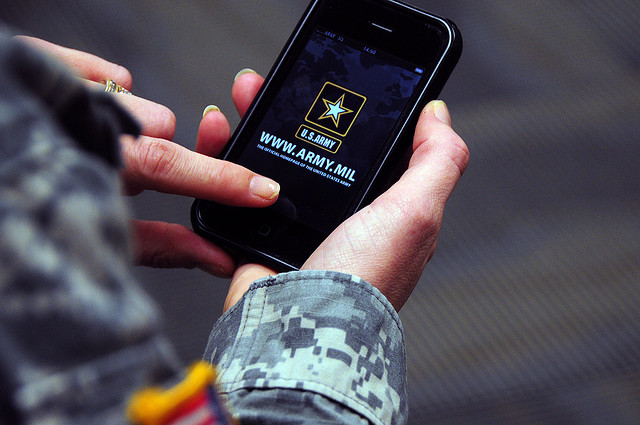Smartphones may soon be as ubiquitous in Army units stationed in Iraq and Afghanistan as they are on the streets of New York, as the Army works on a program to bring smartphones to soldiers on the ground.
The Army believes that smartphones — and certain apps developed by and for the Army — could be a great boon to soldiers on the ground. And the service sees it as inevitable.
“Taking smart-phone technology and bringing them to the battlefield is probably — I shouldn’t say this — but it is something that we need to do,” said Tony Fuiza, a researcher on the program, on a recent call with military bloggers.
The Army first needs to find a way to build its own portable, secure 3G network in places like Afghanistan. That means, according to Fuiza, shrinking normally 100-foot cell phone towers into small units with portable antennas that can be affixed to trucks or backpacks. It also would require that the Army create not only its own apps, but also its own app “store” — and a way to screen apps for viruses and other security threats. And, it definitely means finding a phone that’s tough enough to endure battle conditions.
The Army is currently testing phones, according to spokeswoman Annie Gammell. Yesterday, in fact, soldiers at Fort Bliss in Texas were testing a phone and system built by Monax, a division of Lockheed Martin that’s trying to get into the tactical 3G market.
The Army is also looking at phones your average consumer would be familiar with, like the iPhone or phones on the Android system, Fuiza said.
The Army has been excited about the possibilities of smartphones for a while now. This summer, the Army held an apps contest, lauding the five-month contest as the quicker, sleeker future of the Army’s notoriously sluggish acquisitions process. They’ve already launched a pilot program for new recruits to get smartphones, on which they can download their Army manuals and hear the Soldier’s Creed. They return them after training.
Lt. Gen. Mark Hertling, who’s in charge of the Army’s initial training gave an interview to TIME about the program:
His fingers flit across on the touch screen, and suddenly the Soldier Creed fills the room from the iPhone’s tiny speaker: “I am an American soldier — I am a warrior and a member of a team.” Hertling grins. “You say `OK, well that’s kind of cheesy’ — but no, it’s not — that’s how these young kids learn.”
There are still a lot of questions to be answered. If the Army can build a secure network and find the right phones, who does it give the phones to? Every soldier on the ground? Or restrict it to unit commanders?
“So do you want a smartphone device down to a squad member who is about to kick
down a door? Is it a distraction rather than a help?” Fuiza asked. “Or do you want to keep this at a higher echelon to sergeant or to platoon leader, a company commander, around TOC areas, for example, to do certain kinds of missions?”
Also up in the air: How much a smartphone program like this will cost the Department of Defense, at a time when event the department is being eyed for cuts.









